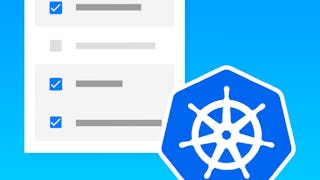Discover how to modernize, manage, and observe applications at scale using Google Kubernetes Engine. This course uses lectures and hands-on labs to help you explore and deploy using Google Kubernetes Engine (GKE), GKE Fleets, Cloud Service Mesh, and Config Controller capabilities that will enable you to work with modern applications, even when they are split among multiple clusters hosted by multiple providers.

il reste 4 jours : Bénéficiez d'un coup de pouce pour le Black Friday avec 160 $ de réduction sur plus de 10 000 programmes.


Ce que vous apprendrez
Describe the challenges of designing a multi-cluster infrastructure.
Describe the components and architecture of GKE Fleets
Identify and describe the core components of a GKE fleet.
Create, connect, and manage GKE clusters from multiple deployment environments.
Compétences que vous acquerrez
- Catégorie : Google Cloud Platform
- Catégorie : Cloud Security
- Catégorie : Authorization (Computing)
- Catégorie : Tensorflow
- Catégorie : Authentications
- Catégorie : Kubernetes
- Catégorie : Vulnerability Scanning
- Catégorie : CI/CD
- Catégorie : Containerization
- Catégorie : Multi-Cloud
- Catégorie : Identity and Access Management
- Catégorie : Cloud-Native Computing
- Catégorie : Role-Based Access Control (RBAC)
- Catégorie : Infrastructure as Code (IaC)
- Catégorie : Istio
- Catégorie : Configuration Management
- Catégorie : Scalability
Détails à connaître

Ajouter à votre profil LinkedIn
novembre 2025
13 devoirs
Découvrez comment les employés des entreprises prestigieuses maîtrisent des compétences recherchées

Il y a 16 modules dans ce cours
In this introduction, you'll explore the course goals and preview each section.
Inclus
1 vidéo
In the first section of this course titled, “Introduction to GKE at Scale,” you’ll learn to recognize the challenges of designing and building multi-environment solutions. Explain how GKE uses fleets to streamline operations. Describe the concepts of sameness and trust and use them to manage fleets. Finally you'll be able to identify the features and components used to manage GKE fleets.
Inclus
5 vidéos1 devoir
In this section of this course titled “Multi-cluster GKE Architecture”, you’ll learn to recognize how GKE can be used to centralize cluster management. Examine the architecture of GKE mulit-cluster clusters. Learn how to create, connect, and manage GKE fleets. You'll also learn how to securely access GKE fleet clusters.
Inclus
5 vidéos1 devoir
This section is about fleets and teams in GKE. You’ll learn how to define GKE fleets. Describe how GKE fleets can solve common cluster management problems. How to manage fleets and teams in GKE. You'll also be able to detail the elements of Fleet management.
Inclus
5 vidéos1 devoir1 élément d'application
In this section of the course, titled “Managing GKE configuration at Scale,” you’ll learn to recognize the challenges of scaling multi-cluster, multi-tenant configurations. Configure a centralized configuration management using GitOps model. Describe the benefits and architecture of Config Sync. Use Policy Controller to enforce security and compliance in GKE. Extend GitOps principles to Google Cloud resources. Finally you will learn how to create a standardized, reusable, and policy-driven foundation for Kubernetes deployments.
Inclus
7 vidéos1 devoir1 élément d'application
In this section of the course, you’ll learn how to explain how fleet networking works. Describe how Pods in a Kubernetes cluster communicate with each other. Enable multi-cluster Services. Configure multi-cluster Services. Detail the elements of fleet management. Outline the role of a multi-cluster gateway. You'll also learn how to configure a multicluster gateway.
Inclus
7 vidéos1 devoir1 élément d'application
In this section, titled, you learn to list and describe the benefits of using Cloud Service Mesh. Install and configure Cloud Service Mesh on different clusters. Trace the path of a request through the mesh, correctly identifying and explaining the role of key components like Envoy proxies, Mesh CA, and extensions in handling the request. Finally you'll learn to create Service Mesh Dashboards from workload telemetry including metrics, traces, and logs.
Inclus
5 vidéos1 devoir1 élément d'application
In this section, titled, you learn to explain how Cloud Service Mesh learns the network from Kubernetes. Deploy mesh API resources such as the VirtualService, DestinationRule, Gateway, Service Entry, and the Sidecar to configure the mesh. Describe how to harden the mesh network by introducing new functionality such as request retries, request timeouts, and circuit breakers. You'll also learn how to explore Service Mesh resilience by creating failures and delays on specific services.
Inclus
7 vidéos1 devoir1 élément d'application
In this section, you learn how to encrypt traffic between microservices to prevent anyone in the network from gaining access to private information. Authorize services and requests, ensuring that services only access the information that is allowed access from other services. Authenticate and authorize services and requests to verify trust among services in the mesh and among end users. You will also see how to limit service access in the network so that granular controls over the communication can be established.
Inclus
5 vidéos1 devoir1 élément d'application
In this section, you learn to set up a multi-cluster mesh with a single subnet in a single VPC network and account for variations like multi-region clusters, multiple projects, shared VPC, and private clusters. You'll also learn to enable communication between GKE clusters on different networks using an east-west gateway and attached clusters.
Inclus
3 vidéos1 devoir1 élément d'application
In this section, you learn to summarize the differences between authentication methods for GKE clusters and explain when to use each. Summarize the key features of connect gateway and explain how it simplifies and secures connections to GKE Enterprise fleet member clusters. Configuring connect gateway for authentication and authorization. Securely access clusters and provide authentication using OpenID Connect (OIDC) and third-party identity providers (IdPs). Finally you'll learn to configure GKE Identity Service to enable authentication and authorization for users when given a GKE cluster and a third-party identity provider (IdP).
Inclus
7 vidéos1 devoir1 élément d'application
In this section, you learn to describe GKE security posture. Navigate and interpret the GKE security posture dashboard to identify security issues. Implement node security measures to protect GKE worker nodes from potential threats. Describe the process of vulnerability scanning in GKE. Finally you will be able to explain the roles and capabilities of Google Cloud's Artifact Analysis and Security Command Center in enhancing GKE security.
Inclus
6 vidéos1 devoir
In this section, you learn to describe the core components of Google Cloud's CI/CD pipeline and how they address common challenges in application modernization. Analyze how Cloud Deploy integrates with GKE to manage Kubernetes manifests and control deployments. Compare and contrast the deployment strategies for Knative Serving within GKE Enterprise. Explain the steps required to establish a peered VPC connection for secure CI/CD in a private network. You will also learn how to evaluate the various security measures and tools available within Google Cloud for securing the software supply chain.
Inclus
9 vidéos1 devoir1 élément d'application
In this section, you learn to explain how GKE serves as a suitable platform for large language models and the increasing demand for hardware accelerators. Describe the high-level architecture of a GKE-based training platform for AI models. Outline the architecture for a GKE-based model serving platform. You will also learn to outline different cost management strategies available when using GKE for AI/ML workloads.
Inclus
5 vidéos1 devoir
The course closes with a summary of the key points covered in each section.
Inclus
1 vidéo
Student PDF links to all modules
Inclus
15 lectures
Instructeur

Offert par
En savoir plus sur Cloud Computing
 Statut : Essai gratuit
Statut : Essai gratuitGoogle Cloud
Pour quelles raisons les étudiants sur Coursera nous choisissent-ils pour leur carrière ?





Ouvrez de nouvelles portes avec Coursera Plus
Accès illimité à 10,000+ cours de niveau international, projets pratiques et programmes de certification prêts à l'emploi - tous inclus dans votre abonnement.
Faites progresser votre carrière avec un diplôme en ligne
Obtenez un diplôme auprès d’universités de renommée mondiale - 100 % en ligne
Rejoignez plus de 3 400 entreprises mondiales qui ont choisi Coursera pour les affaires
Améliorez les compétences de vos employés pour exceller dans l’économie numérique
Foire Aux Questions
Yes, you can preview the first video and view the syllabus before you enroll. You must purchase the course to access content not included in the preview.
If you decide to enroll in the course before the session start date, you will have access to all of the lecture videos and readings for the course. You’ll be able to submit assignments once the session starts.
Once you enroll and your session begins, you will have access to all videos and other resources, including reading items and the course discussion forum. You’ll be able to view and submit practice assessments, and complete required graded assignments to earn a grade and a Course Certificate.
Plus de questions
Aide financière disponible,




